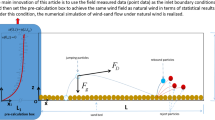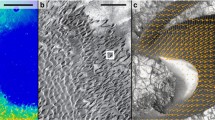Abstract
The near-bed airflow and the movement of sand dune sediments by wind are fundamental dune geomorphological processes. This research measured the wind profiles and sand mass flux on the rounded top of a transverse dune at the southern edge of the Tengger Desert to examine how to best predict the vertical profile of sand flux. This work also tested the accuracy of previously developed models in predicting the apparent roughness length during saltation. Results show that mass flux vertical distribution over the dune top is underestimated by an exponential function, overestimated by a power function, but closely matches the predictions made using the LgstcDoseRsp function. Given suitable values of α, β and γ according to the grain size composition, Sørensen equation with the peaked shape of the mass transport curve will well predict the dimensionless mass flux qg/ρu*3 against dimensionless shear velocity u*/u* t . The modified Charnock model works best of the previously published models tested, with an R 2 of 0.783 in predicting the enhanced roughness over the moving sand surface, as opposed to an R 2 of 0.758 for the Owen model and an R 2 of 0.547 for the Raupach model. For the rounded dune top in this study, C m =0.446±0.016.
Similar content being viewed by others
References
Anderson R S, Haff P K. 1988. Simulation of eolian saltation. Science, 241: 820–823
Anderson R S, Haff P K. 1991. Wind modification and bed response during saltation of sand in air. Acta Mech, (Supp. 1): 21–51
Andeson R S, Hallet B. 1986. Sediment transport by wind: Toward a general model. Geol Soc Am Bull, 97: 523–535
Andreotti B. 2004. A two-species model of aeolian sand transport. J Fluid Mech, 510: 47–70
Baas A C W, Sherman D J. 2005. Formation and behavior of aeolian streamers. J Geophys Res, 110: F03011, doi: 10.1029/2004JF000270
Bagnold R A. 1936. The movement of desert sand. Proc R Soc A, 157: 594–620
Bagnold R A. 1941. The Physics of Blown Sand and Desert Dunes. London: Methuen
Bagnold R A. 1937. The transport of sand by wind. Geograph J, 89: 409–438
Bauer B O, Houser C A, Nickling W G. 2004. Analysis of velocity profile measurements from wind-tunnel experiments with saltation. Geomorphology, 59: 81–98
Butterfield G R. 1993. Sand transport response to fluctuating wind velocity. In: Clifford N J, French J R, Hardisty J, eds. Turbulence: Perspectives on Flow and Sediment Transport. New York: John Wiley. 305–335
Charnock H. 1995. Wind stress on a water surface. Quart J Roy Meteor Soc, 81: 639–640
Dong Z B, Gao S Y, Fryrear D W. 2001. Drag coefficients, roughness length and zero-plane displacement height as disturbed by artificial standing vegetation. J Arid Environ, 49: 485–505
Dong Z B, Liu X P, Wang H T, et al. 2003. The flux profile of a blowing sand cloud: A wind tunnel investigation. Geomorphology, 49: 219–230
Dong Z B, Liu X P, Wang H T. 2003. The aerodynamic roughness with a blowing sand boundary layer (BSBL): A redefinition of the Owen effect. Geophys Res Lett, 30: 1047–1050
Dong Z B, Wang H T, Liu X P, et al. 2004. The blown sand flux over a sandy surface: A wind tunnel investigation on the fetch effect. Geomorphology, 57: 117–127
Farrell E J, Sherman D J, Ellis J T, et al. 2012. Vertical distribution of grain size for wind blown sand. Aeolian Res, 7: 51–61
Farrell E J. 1999. An investigation of surface-wind systems for aeolian saltation: Field and laboratory experiments. M. S. Thesis. Department of Geography, University of S. California, Los Angeles
Fearnehough W, Fullen M A, Mitchell D J, et al. 1998. Aeolian deposition and its effect on soil and vegetation changes on stabilized desert dunes in northern China. Geomorphology, 23: 171–182
Gillette D A, Herbert G, Stockton P H, et al. 1996. Causes of the fetch effect in wind erosion. Earth Surf Process Landf, 21: 641–659
Greeley R, Blumberg D G, Williams S H. 1996. Field measurements of the flux and speed of wind-blown sand. Sedimentology, 43: 41–52
Has, Dong G R, Wang G Y. 1999. Morphodynamic study of reticulate dunes at southeastern fringe of Tengger Desert. Sci China Ser D-Earth Sci, 42: 207–215
Hopwood J M, Scott W D. 1997. A mathematical model of saltation. Acta Mech, 124: 199–211
Hsu S. 1971. Wind stress criteria in eolian sand transport. J Geophys Res, 76: 8684–8686
Iversen J D, Rasmussen K R. 1999. The effect of wind speed and bed slope on sand transport. Sedimentology, 46: 723–731
Ji S B, Gerber A G, Sousa A C M. 2004. A convection-diffusion CFD model for aeolian saltation. Int J Numer Methods Fluids, 45: 797–817
Kadib A A. 1965. A function for sand movement by wind. University of California Hydraulics Engineering Laboratory Report HEL 2-8. UCLA-Berkeley, Berkeley, CA
Kawamura R. 1951. Study of sand movement by wind. The Reports of the Institute of Science and Technology, vol 5. University of Tokyo, Japan. 95–112
Kind R J. 1976. A critical examination of the requirements for model simulation of wind-induced erosion-deposition phenomena such as snow drifting. Atmos Environ, 10: 219–227
Kok J F, Lacks D J. 2009. Electrification of granular system of identical insulators. Phys Rev E, 79: 051304
Kok J F, Renno N O. 2009. A comprehensive numerical model of steady state saltation (COMSALT). J Geophys Res, 114: D17204, doi: 10.1029/2009JD011702
Lettau K, Lettau H H. 1978. Experimental and micro-meteorological field studies of dune migration. In: Lettau K, Lettau H H, eds. Exploring the World’s Driest Climate. IES Report 101, Institute of Environmental Studies, University of Wisconsin. Madison. 110–147
Li B, Sherman D J, Farrell E J, et al. 2010. Variability of the apparent von Kármán parameter during aeolian saltation. Geophys Res Lett, 37: L15404, doi: 10.1029/2010GL044068
Li J. 1988. Wind regime and shifting sand movement in Shapotou area. J Desert Res, 8: 41–52
Maegley W J. 1976. Saltation and Martian sandstorms. Rev Geophys, 14: 135–142
McEwan I K, Willetts B B. 1991. Numerical model of the saltation cloud. Acta Mech, (Supp. 1): 53–66
Namikas S L. 2003. Field measurement and numerical modeling of aeolian mass flux distributions on a sandy beach. Sedimentology, 50: 303–326
Neuman C M, Maljaars M. 1997. Wind tunnel measurement of boundary-layer response to sediment transport. Bound-Layer Meteor, 84: 67–83
Ni J R, Li Z S, Mendoza C. 2002. Vertical profiles of aeolian sand mass flux. Geomorphology, 49: 205–218
Nikuradse J. 1933. Laws of flow in rough pipes (1950 translation). Technical Memoranda, 1292. Washington, D. C: National Advisory Committee on Aeronauts
Owen P R. 1964. Saltation of uniform grains in air. J Fluid Mech, 20: 225–242
Rasmussen K R, Iversen J D, Rautaheimo P. 1996. Saltation and wind-flow interaction in a variable slope wind tunnel. Geomorphology, 17: 19–28
Rasmussen K R, Mikkelsen H E. 1998. On the efficiency of vertical array aeolian field traps. Sedimentology, 45: 789–799
Rasmussen K R, Sørensen M, Willetts B B. 1985. Measurement of saltation and wind strength on beaches. In: Barndorff-Nielsen O E, Møller J T, Rasmussen K R, et al., eds. Proceedings of International Workshop on the Physics of Blown Sand. Mem. 8(2), Dept. of Theor. Stat., Aarhus Univ., Aarhus, Denmark. 301–326
Raupach M R. 1991. Saltation layers, vegetation canopies and roughness lengths. Acta Mech, (Supp. 1): 83–96
Sauermann G, Kroy K, Herrmann H J. 2001. A continuum saltation model for sand dunes. Phys Rev E, 64: 31305–31316
Shao Y. 2005. A similarity theory for saltation and application to aeolian mass flux. Bound-Layer Meteor, 115: 319–338
Shapotou Scientific Experiment Station. 1991. Principles and Measures of Sand Fixation in the Shapotou Area of the Baotou-Lanzhou Railway. Yinchuan: Ningxia People’s Publishing House
Sherman D J, Farrell E J. 2008. Aerodynamic roughness lengths over movable beds: Comparison of wind tunnel and field data. J Geophys Res, 113: F02S08, doi: 10.1029/2007JF000784
Sherman D J, Li B. 2012. Predicting aeolian sand transport rates: A reevaluation of models. Aeolian Res, 3: 371–378
Sherman D J. 1992. An equilibrium relationship for shear velocity and roughness length in aeolian saltation. Geomorphology, 5: 419–431
Shi F, Huang N. 2010. Computational simulations of blown sand fluxes over the surface of complex microtopography. Environ Model Software, 25: 362–367
Sørensen M, McEwan I K. 1996. On the effect of mid-air collisions on aeolian saltation. Sedimentology, 43: 65–76
Sørensen M. 1991. An analytical model of windblown sand transport. In: Barndorff-Nielsen O E, Willetts B B, eds. Aeolian Grain Transport. Acta Mech, (Supp. 1): 67–81
Sørensen M. 2004. On the rate of aeolian sand transport. Geomorphology, 59: 53–62
Sterk G, Parigiani J, Cittadini E, et al. 2012. Aeolian sediment mass fluxes on a sandy soil in Central Patagonia. Catena, 95: 112–123
Watts I E M. 1969. Climates of China and Korea. In: Arakawa H, ed. Climates of Northern and Eastern Asia. World Survey of Climatology, vol. 8. Amsterdam: Elsevier. 1–75
White B R, Mounla H. 1991. An experimental study of Froude number effect on wind-tunnel saltation. Acta Mech, (Supp. 1): 145–157
White B R. 1979. Soil transport by winds on Mars. J Geophys Res, 84: 4643–4651
Williams G. 1964. Some aspects of the eolian saltation load. Sedimentology, 3: 257–287
Wu J J, Luo S H, He L H. 2012. The characteristics of streamwise mass flux of windblown sand movement. Geomorphology, 139–140: 188–194
Wu Z. 1987. Aeolian Geomorphology. Bei**g: Science Press
Zhang C L, Zou X Y, Pan X H, et al. 2007. Near-surface airflow field and aerodynamic characteristics of the railway-protection system in the Shapotou region and their significance. J Arid Environ, 71: 169–187
Zhao X. 1988. Problems of revegetation on sand dunes in Shapotou area. In: Studies of Dune Control in Shapotou Area. Shapotou Scientific Experimental Station, Lanzhou Institute of Desert Research, Academia Sinica. Yinchuan: Ningxia People’s Publishing House. 27–58
Zheng X J, He H L, Wu J J. 2004. Vertical profile of mass flux for windblown sand movement at steady state. J Geophys Res, 109: B01106, doi: 10.1029/2003JB002656
Zingg A W. 1953. Wind tunnel studies of the movement of sedimentary material. Proceedings of 5th Hydraulic Conference, Institute of Hydraulics, Iowa City. 111–135
Author information
Authors and Affiliations
Corresponding author
Rights and permissions
About this article
Cite this article
Zhang, C., Zhou, N. & Zhang, J. Sand flux and wind profiles in the saltation layer above a rounded dune top. Sci. China Earth Sci. 57, 523–533 (2014). https://doi.org/10.1007/s11430-013-4672-8
Received:
Accepted:
Published:
Issue Date:
DOI: https://doi.org/10.1007/s11430-013-4672-8




